Related Research Articles

The sap beetles, also known as Nitidulidae, are a family of beetles.

The longhorn beetles (Cerambycidae), also known as long-horned or longicorns, are a large family of beetles, with over 35,000 species described.
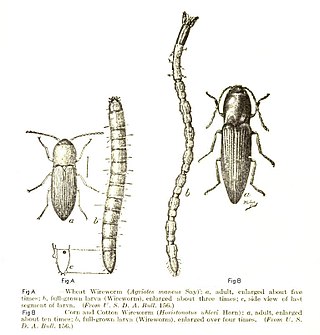
Elateridae or click beetles are a family of beetles. Other names include elaters, snapping beetles, spring beetles or skipjacks. This family was defined by William Elford Leach (1790–1836) in 1815. They are a cosmopolitan beetle family characterized by the unusual click mechanism they possess. There are a few other families of Elateroidea in which a few members have the same mechanism, but most elaterid subfamilies can click. A spine on the prosternum can be snapped into a corresponding notch on the mesosternum, producing a violent "click" that can bounce the beetle into the air. Clicking is mainly used to avoid predation, although it is also useful when the beetle is on its back and needs to right itself. There are about 9300 known species worldwide, and 965 valid species in North America.
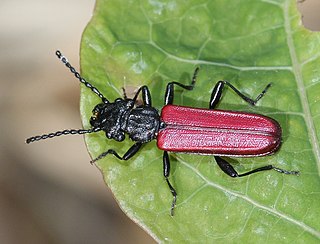
The Cucujidae, or flat bark beetles, are a family of distinctively flat beetles found worldwide under the bark of dead trees. The family has received considerable taxonomic attention in recent years and now consists of 70 species distributed in five genera. It was indicated Cucujus species are scavengers, only feeding on pupae and larvae of other insects and on other subcortical beetles such as their own. Since the Cucujidae prey on larvae of potentially tree damaging beetles that spread fungal diseases, they are considered to be beneficial to the health of living trees.
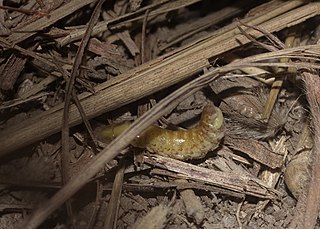
The Rhagophthalmidae are a family of beetles within the superfamily Elateroidea. Members of this beetle family have bioluminescent organs on the larvae, and sometimes adults, and are closely related to the Phengodidae, though historically they have been often treated as a subfamily of Lampyridae, or as related to that family. Some recent evidence suggested that they were the sister group to the Phengodidae, and somewhat distantly related to Lampyridae, whose sister taxon was Cantharidae, but more reliable genome-based phylogenetics placed as the sister group to the Lampyridae.

Brentidae, sometimes known as the primitive weevils, is a cosmopolitan family of primarily xylophagous beetles also known as straight-snouted weevils. The concept of this family has been expanded with the inclusion of three groups formerly placed in the Curculionidae; the subfamilies Apioninae, Cyladinae, and Nanophyinae, as well as the Ithycerinae, previously considered a separate family. They are most diverse in the tropics, but occur throughout the temperate regions of the world. They are among the families of weevils that have non-elbowed antennae, and tend to be elongate and flattened, though there are numerous exceptions.
Catherine N. Duckett is the Associate Dean of the School of Science at Monmouth University. Formerly she worked as Associate Director of the Office for the Promotion of Women in Science, Engineering and Mathematics, and the Program Manager of the Ocean Biogeographic Information System at Rutgers University, as well as a former Associate professor of Biology at University of Puerto Rico at Rio Piedras. She is also a prominent systematic entomologist, specializing in the phylogeny of flea beetles, and an adjunct professor at Rutgers.

The minute tree-fungus beetles, family Ciidae, are a sizeable group of beetles which inhabit Polyporales bracket fungi or coarse woody debris. Most numerous in warmer regions, they are nonetheless widespread and a considerable number of species occur as far polewards as Scandinavia for example.
Trachelostenus is a genus of darkling beetles in the family Tenebrionidae. It is native to the Valdivian forests of Chile, and has at least two species, T. inaequalis (Solier) and T. fascicularis (Philipp). It was historically considered the only member of the family Trachelostenidae, but a 2015 study sunk the genus into the tenebrionid subfamily Tenebrioninae.

Wanda Wesołowska is a Polish zoologist known for her work with jumping spiders. She has described more species of jumping spider than any contemporary writer, and is second only to Eugène Simon in the history of arachnology. Originally a student of ornithology, she developed an interest in jumping spiders while still a student at the Siedlce University of Natural Sciences and Humanities in the 1970s.

Anamorphidae is a family of beetles in the superfamily Coccinelloidea, formerly included within the family Endomychidae. They are found worldwide. Like enchomyids, they are fungivores, with adult and larval stages thought to exclusively consume fungal spores.

Eupsilobiidae is a family of beetles in the superfamily Coccinelloidea, formerly included within the family Endomychidae. Most genera are restricted to the Neotropics, while the genus Eidoreus is found worldwide. They are fungivores, and have been observed living commensally in bee and ant nests.

Eumolpini is a tribe of leaf beetles in the subfamily Eumolpinae. It is the largest tribe in the subfamily, with approximately 170 genera found worldwide. Members of the tribe almost always have a longitudinal median groove on the pygidium, which possibly helps to keep the elytra locked at rest. They also generally have a subglabrous body, as well as appendiculate pretarsal claws.
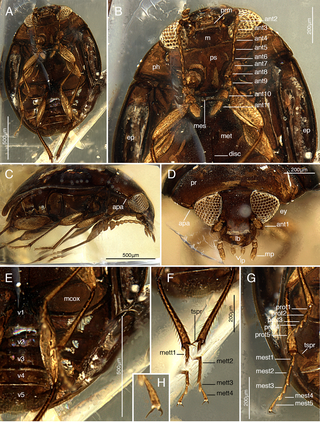
Cyclaxyridae are a family of beetles in the superfamily Cucujoidea. The only living genus is Cyclaxyra, with two species endemic to New Zealand. Other species have been named from fossils. They are also known as sooty mould beetles due to the association of Cyclaxyra with sooty mould. The extant species are mycophagous, feeding on spores, conidia, and hyphae.
2018 in paleoentomology is a list of new fossil insect taxa that were described during the year 2018, as well as other significant discoveries and events related to paleoentomology that were scheduled to occur during the year.
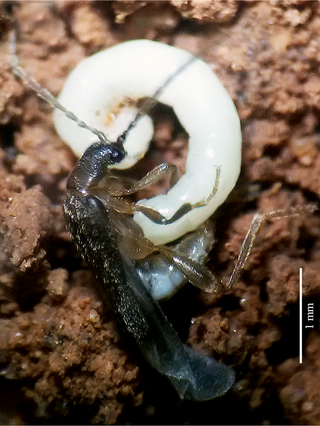
Jurasaidae is a family of elateroid beetles known from around a half-dozen species in two genera found the Brazilian Atlantic rainforest including drier transitional areas bordering the Caatinga. All known species have neotenic larva-like females and normal males, similar to some other elateroids. They occur in the soil horizon immediately under leaf litter, with the larvae likely being fungivorous, consuming the fluids of fungal hyphae.

Epimetopidae is a family of semi-aquatic beetles belonging to the Hydrophiloidea. They are found in sand and gravel at the edges of streams, rivers and shallow freshwater ponds. These beetles are shorter than half a centimeter long and have a pronotum with a central projection forming a shelf above the head. On the underside of the abdomen only four sternites are visible. There are approximately 72 described species in three genera, Epimetopus which is restricted to the New World, mostly Neotropical, Eupotemus with two Afrotropical species and Eumetopus with some Oriental species. Females carry their eggcases on the underside of the abdomen. The larvae are probably carnivorous based on their mouthparts and likely live in the same habitats as the adults.
This paleoentomology list records new fossil insect taxa that were to be described during the year 2021, as well as notes other significant paleoentomology discoveries and events which occurred during that year.
Phaeoxantha is a genus of tiger beetles in the family Cicindelidae, formerly included within the genus Megacephala.
References
- ↑ Shockley, F. W.; Tomaszewska, K. W.; Mchugh, J. V. (2009-02-04). "An annotated checklist of the handsome fungus beetles of the world (Coleoptera: Cucujoidea: Endomychidae)". Zootaxa. 1999 (1): 1–113. doi:10.11646/zootaxa.1999.1.1. ISSN 1175-5334.
- ↑ https://archive.org/details/CentreForEntomologicalStudiesAnkaraMiscellaneousPapers151/page/n5/mode/2up